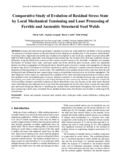JavaScript is disabled for your browser. Some features of this site may not work without it.
| dc.contributor.author | Sule, Jibrin | |
| dc.contributor.author | Ganguly, Supriyo | |
| dc.contributor.author | Coules, Harry E. | |
| dc.contributor.author | Pirling, T. | |
| dc.date.accessioned | 2016-05-04T13:51:12Z | |
| dc.date.available | 2016-05-04T13:51:12Z | |
| dc.date.issued | 2015-02-21 | |
| dc.identifier.citation | Sule, J. et al. (2015) Comparative study of evolution of residual stress state by local mechanical tensioning and laser processing of ferritic and austenitic structural steel welds, Journal of Mechanical Engineering and Automation, Vol. 5, Iss. 1, pp. 33-42 | en_UK |
| dc.identifier.issn | 2163-2405 | |
| dc.identifier.uri | http://dx.doi.org/10.5923/j.jmea.20150501.05 | |
| dc.identifier.uri | https://dspace.lib.cranfield.ac.uk/handle/1826/9856 | |
| dc.description.abstract | Complex thermal stresses generated in welded structures are undesirable but inevitable in fusion welding. The presence of residual stresses can be detrimental to the integrity of a welded joint. In this research, redistribution of residual stress magnitude and profile was studied and compared in two multi-pass welded structural alloys (API X100 and 304L stainless steel) after cold rolling and laser processing. The residual stress field was studied by neutron diffraction using the SALSA strain scanner at their reactor neutron source at ILL, Grenoble. In addition to a complex distribution of residual stress state, multi-pass welds also forms dendritic grain structure, which are repeatedly heated, resulting in segregation of alloying elements. Dendritic grain structure is weaker and segregation of alloying elements may result in formation of corrosion microcells as well as reduction in overall corrosion prevention due to depletion of alloying elements in certain areas. The modification of as-welded residual stress state was done by cold rolling which was followed by laser processing to create a recrystallized microstructure to minimise segregation. The main objective of this study is to understand the suitability of this novel manufacturing technique to create a stress free weldment with recrystallised grain structure. Hardness evolution in the welded structures was scanned following welding, post weld cold rolling and cold rolling followed by laser processing. Hardness distribution in both the structural alloys showed a significant evidence of plastic deformation near the cap pass of the weld metal. Residual stress redistribution was observed up to 4 mm from the capping pass for ferritic steel, while in austenitic steel weld, post weld cold rolling was effective in modifying the residual stress redistribution throughout the entire thickness. Laser processing in both cases reinstated the as-welded residual stress distribution and resulted in softening of the strained area. | en_UK |
| dc.language.iso | en | en_UK |
| dc.publisher | Scientific & Academic Publishing Co. | en_UK |
| dc.subject | Ferritic and austenitic structural steel | en_UK |
| dc.subject | Residual stress | en_UK |
| dc.subject | Multi-pass welds | en_UK |
| dc.subject | Neutron diffraction | en_UK |
| dc.subject | Rolling laser processing | en_UK |
| dc.title | Comparative study of evolution of residual stress state by local mechanical tensioning and laser processing of ferritic and austenitic structural steel welds. | en_UK |
| dc.type | Article | en_UK |
Files in this item
This item appears in the following Collection(s)
-
Staff publications (SATM) [4364]
